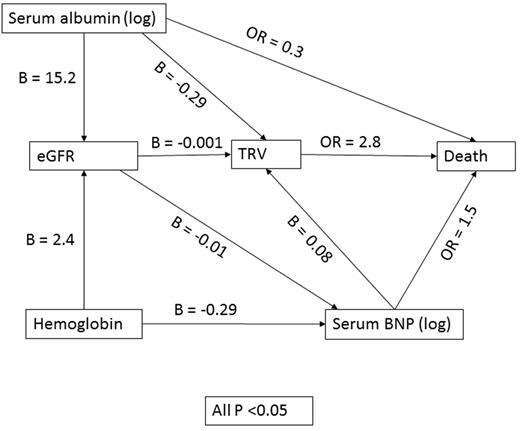Abstract

Introduction:
Sickle cell disease, which has long been known as a disease of childhood, has progressively extended to the adult world with improvement in life expectancy. Identifying new biomarkers in SCD has the potential to identify new pathophysiological pathways or targets for disease modifying strategies or prognostic indicators. In this study, we analyzed screening data from a multicenter clinical trial to test the role of albumin, a commonly overlooked laboratory marker, in sickle cell disease as a potential biomarker. We also used a more recently popularized statistical method to better understand the multivariate data and generate a causal hypothesis.
Methods:
Serum albumin levels were correlated with demographic, clinical and laboratory findings in 660 patients screened for the Treatment of Pulmonary Hypertension and Sickle Cell Disease with Sildenafil Treatment (walk-PHaSST; NCT00492531). Serum albumin and amino terminal pro-brain natriuretic peptide (NT-proBNP) levels were log transformed. Associations were tested by Pearson correlation coefficient, Cox proportional hazard analysis, linear regression modeling and Generalized Structural Equation Modeling was used for multivariable analysis.
Results:
A strong positive correlation was found between serum albumin and estimated glomerular filtration rate (eGFR, rho=0.28, p < 0.001). Serum albumin level also correlated with an echocardiographic marker of risk of pulmonary hypertension, tricuspid regurgitant velocity (TRV, rho=-0.24, p<0.001). Significantly, lower serum albumin level was associated with greater mortality (hazard ratio 0.93, p<0.001). A conventional logistic regression model indicated that independent risk factors for death included albumin, NT-proBNP and TRV. The path analysis showed direct and indirect correlation among the variables albumin, eGFR, TRV, hemoglobin level and NT-proBNP to death. Albumin showed a negative direct relationship with death (OR = 0.3, p = 0.006) and TRV (β=-0.29, p < 0.001), and a positive correlation with eGFR (β=15, p=0.005). As previously known, TRV showed a positive relationship with mortality, indicating that albumin and mortality had both direct and indirect correlation via TRV.
Conclusions:
This hypothesis-generating investigation suggests that low serum albumin level predicts risk of nephropathy, pulmonary vasculopathy and death. The latter three had already been linked to each other in several different sickle cell cohorts in the published literature. However, this is the first analysis to point to a relatively low magnitude but statistically very significant relationship of serum albumin level to clinical outcomes in sickle cell disease. Additional research is warranted to validate these findings and determine the mechanisms involved.
Kato: MAST Therapeutics: Research Funding; Global Blood Therapeutics: Consultancy; Bayer: Research Funding; Novartis: Consultancy.
Author notes
Asterisk with author names denotes non-ASH members.

This icon denotes a clinically relevant abstract


